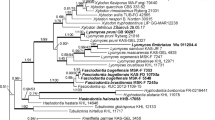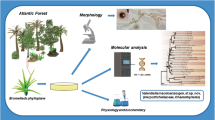Abstract
Two strains of a basidiomycetous yeast were derived from an insect trypanosomatid culture isolated from the intestine of a plant bug, Collaria oleosa (Heteroptera: Miridae), collected in Costa Rica. The yeast did not form ballistoconidia but reproduced only by budding. Teliospores were not observed in individual and crossed cultures of each strain. Morphological and other taxonomic characteristics of the yeast were similar to those of the species in the polyphyletic genus Rhodotorula. However, molecular phylogeny inferred from the internal transcribed spacers and D1/D2 region of the large subunit rRNA gene showed that the strains represent a new species placed among the smut fungi in the family Ustilentylomataceae, which includes Aurantiosporium subnitens, Fulvisporium restifaciens, Ustilentyloma fluitans, and Rhodotorula hordea. Given the well distinguished phylogenetic position of this novel species within the Ustilentylomataceae, we propose Microbotryozyma collariae gen. nov., sp. nov. to accommodate the yeast isolated from C. oleosa, with strain American Type Culture Collection MYA-4666T (= PRA303-1S = CBS 12537) designated as the type strain.



Similar content being viewed by others
References
Altschul SF, Gish W, Miller W, Myers EW, Lipman DJ (1990) Basic Local Alignment Search Tool. J Mol Biol 215:403–410
Barnett JA, Payne RW, Yarrow D (2000) Yeasts: characteristics and identification, 3rd edn. Cambridge University Press, Cambridge
Brooks MA (1963) The microorganisms of healthy insects. In: Steinhaus EA (ed) Insect pathology: an advanced treatise. Academic, London, pp 215–250
Buchner P (1965) Endosymbiosis of animals with plant microorganisms. Wiley, New York
Felsenstein J (2004) PHYLIP (Phylogeny Inference Package) version 3.6. Distributed by the author. Department of Genome Sciences, University of Washington, Seattle
Kurtzman CP (2006) Yeast species recognition from gene sequence analyses and other molecular methods. Mycoscience 47:65–71
Kurtzman CP, Fell JW, Boekhout T, Robert V (2011) Methods for isolation, phenotypic characterization and maintenance of yeasts. In: Kurtzman CP, Fell JW, Boekhout T (eds) The yeasts, a taxonomic study, 5th edn. Elsevier, London, pp 87–110
Maslov DA, Yurchenko VY, Jirků M, Lukeš J (2010) Two new species of trypanosomatid parasites isolated from Heteroptera in Costa Rica. J Eukaryot Microbiol 57:177–188
Nardi JB, Bee CM, Miller LA, Nguyen NH, Suh S-O, Blackwell M (2006) Communities of microbes that inhabitat the changing hind gut landscape of a subsocial beetle. Arthropod Struct Dev 35:57–68
Ronquist F, Huelsenbeck JP (2003) MRBAYES 3: Bayesian phylogenetic inference under mixed models. Bioinformatics 19:1572–1574
Sampaio JP (2011) Rhodotorula Harrison. In: Kurtzman CP, Fell JW, Boekhout T (eds) The yeasts, a taxonomic study, 5th edn. Elsevier, London, pp 1873–1927
Scorzetti G, Fell JW, Fonseca A, Statzell-Tallman A (2002) Systematics of basidiomycetous yeasts: a comparison of large subunit D1/D2 and internal transcribed spacer rDNA regions. FEMS Yeast Res 2:495–517
Shifrine M, Phaff HJ (1956) The association of yeasts with certain bark beetles. Mycologia 48:41–55
Suh S-O, Zhou JJ (2010) Methylotrophic yeasts near Ogataea (Hansenula) polymorpha: a proposal of O. angusta comb. nov. and Candida parapolymorpha sp. nov. FEMS Yeast Res 10:631–638
Suh S-O, McHugh JV, Pollock DD, Blackwell M (2005) The beetle gut: a hyperdiverse source of novel yeasts. Mycol Res 109:261–265
Swofford DL (2002) PAUP. Phylogenetic analysis using parsimony (*and other methods), version 4.0b10. Sinauer Associates, Sunderland
Tanada Y, Kaya HK (1993) Associations between insects and nonpathogenic microorganisms. In: Tanada Y, Kaya HK (eds) Insect pathology. Academic, New York, pp 12–51
Tatusova TA, Madden TL (1999) Blast 2 sequences—a new tool for comparing protein and nucleotide sequences. FEMS Microbiol Lett 174:247–250
Thompson JD, Gibson TJ, Plewniak F, Jeanmougin F, Higgins DG (1997) The CLUSTAL X windows interface: flexible strategies for multiple sequence alignment aided by quality analysis tool. Nucleic Acids Res 25:4876–4882
van der Walt JP, Scott DB, van der Klift WC (1971) Four new, related Candida species from South African insect sources. Antonie Van Leeuwenhoek 37:449–460
Vánky K (2002) Illustrated genera of smut fungi, 2nd edn. APS Press, St. Paul
Zhang N, Suh S-O, Blackwell M (2003) Microorganisms in the gut of beetles: evidence from molecular cloning. J Invertebr Pathol 84:226–233
Acknowledgments
We thank Drs. Brian Beck and Dominik Begerow for their useful comments during this study, and Neil Hetrick, ATCC Protistology Collection, for his assistance in the culture of Leptomonas barvae (ATCC PRA-303). We are also grateful to Pushpa Gujjari and Janice L. Houseknecht, ATCC Mycology Collection, for their assistance in characterizing the yeasts. Many thanks to the two anonymous reviewers for their valuable comments, especially on proposing a novel genus in this manuscript.
Author information
Authors and Affiliations
Corresponding author
Additional information
The GenBank accession numbers for the ribosomal RNA gene sequences determined in this study are JN849458 to JN849461.
Rights and permissions
About this article
Cite this article
Suh, SO., Maslov, D.A., Molestina, R.E. et al. Microbotryozyma collariae gen. nov., sp. nov., a basidiomycetous yeast isolated from a plant bug Collaria oleosa (Miridae). Antonie van Leeuwenhoek 102, 99–104 (2012). https://doi.org/10.1007/s10482-012-9717-z
Received:
Accepted:
Published:
Issue Date:
DOI: https://doi.org/10.1007/s10482-012-9717-z




